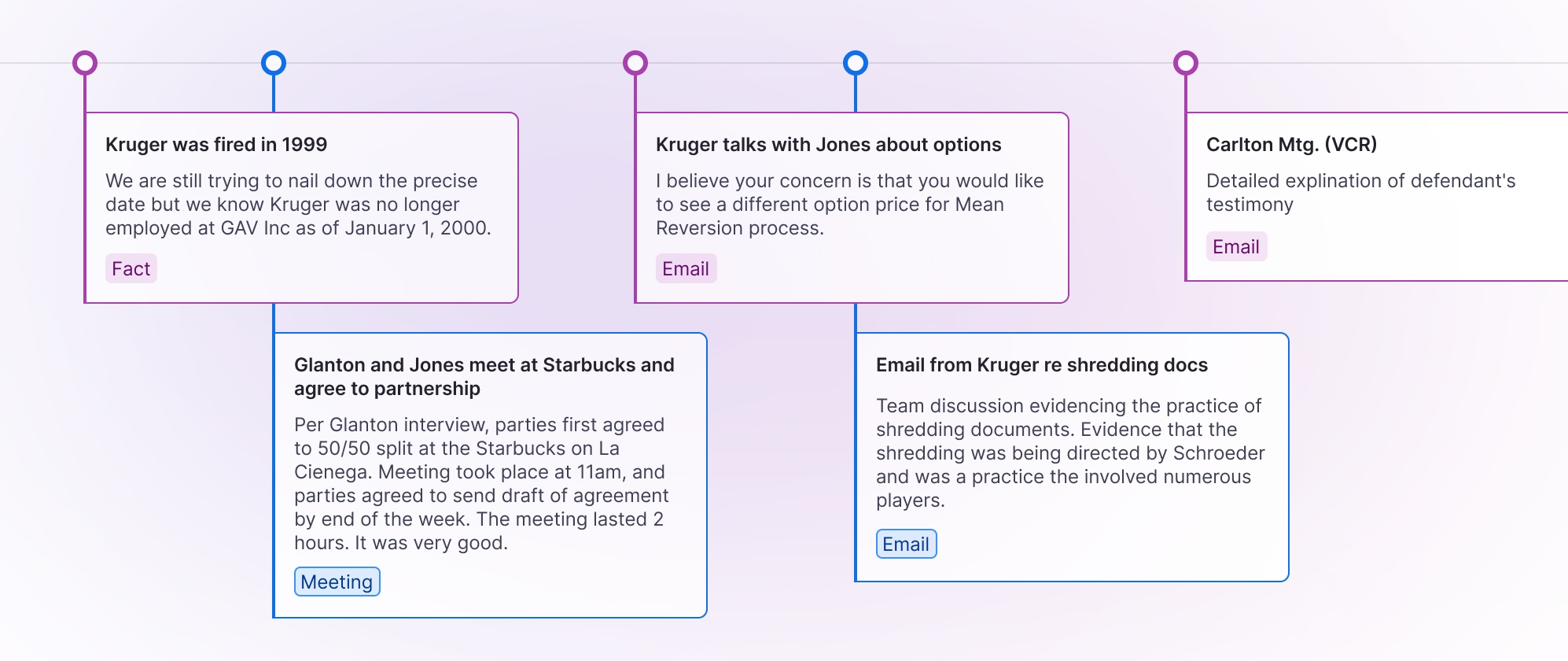
Every case has a story. This story is made up of facts. Those facts can be captured in emails or documents. They can come up in responses to written discovery requests or in oral testimony. Facts can be reflected in texts or chats. (Never underestimate the evidentiary weight of a well-placed emoji.) They can also be conveyed orally, like at a witness interview, and more informally, like at a meeting or call with a client. Every case team needs to understand the story of their case and that means understanding how these key facts unfold.
To capture these stories, lawyers turn to case chronologies. In the legal context, a chronology is a working document that lays out the facts of a case or investigation in a series of individual entries. Typically, these entries are presented in a linear fashion playing out over time, though there are practices that use a claim- or issue- focused structure. (These chronologies tend to be not as chronological).
The chronology cannot live where the document review is being done. It is not sufficient to filter your reviewed documents for anything tagged “hot” or “important,” include the word “chronology” in your saved search name and call it a day. This is why every e-discovery platform expanding into this space has built or is building a separate tool for it. E-discovery serves a distinct purpose and case teams need something else for their substantive fact development work. That said, there’s a symbiotic relationship between the case chronology and your e-discovery platform of choice. The subset of reviewed documents with <insert your important tag here> likely contains many of the key factual building blocks for your chronology. Think of it this way: the e-discovery platform helps you find the potential needles in the haystack and the chronology is where you actually work with those needles.
Whereas e-discovery documents are coded - for responsiveness, privilege and issues, among other things – chronology entries are opinionated. In addition to a factual summary, each entry includes the case team’s take on the document: Why is it important and what does it mean for the client and the case. Who from the cast of characters was aware of this, involved in it or otherwise related to it. What issues are associated with the fact and how are they impacted by it. Ultimately, the team needs to understand the parts of the story that are favorable and those that are not so much.
The mere inclusion of a document in a chronology on its own is meaningful. There is an analytical filter between the e-discovery database and the chronology. When a document gets through that and is elevated to the chronology, it has met a substantive threshold of criticality to the case. Once a document is in the chronology, it now lives among the other needles. “Hot” for review purposes does not necessarily translate to “hot” for chronology purposes. The scale for importance shifts at this stage and requires a separate analysis. This is especially the case when the document review is performed by first-level reviewers that are not part of the substantive case team.
The chronology is a living document that evolves over the life of a case. It often starts at the outset of a case, well before data is even collected, let alone processed and reviewed. At that point, you have just a few pieces of the puzzle. You are mostly trying to build out the border, understand the parameters and identify sources for further exploration. Facts get added and updated over time, and some facts get demoted or removed as new information comes to light. The chronology can inform your review by identifying priority custodians, time periods or other specific points of focus (e.g., particular transactions or keywords). The results of the targeted review then make the chronology even more robust, which leads to more insights and more areas of interest for the reviewers to spotlight. This is the ultimate symbiosis between chronology and review, and why I strongly advise teams not to wait until a review is done to start on their chronology.
To better understand existing practices at firms, we conducted a survey with lawyers at AmLaw firms on their approach to case chronologies. (We only reached out to users who were not already using Everchron.) Two big findings emerged: First, every single respondent indicated that they create a case chronology on every case. Second, 90% of respondents indicated that they use Excel or Word to build these chronologies. For a task that teams perform on every case and investigation, firms and legal departments need a purpose-built case management tool to ensure effective and collaborative fact development. Just as the legal profession outgrew bankers boxes and then Acrobat to get to e-discovery software, it has now outgrown Word, Excel and similar general purpose tools for building chronologies and conducting case analysis.
[Originally published in C.A.N., the Canadian ACEDS Newsletter, Spring 2022]

